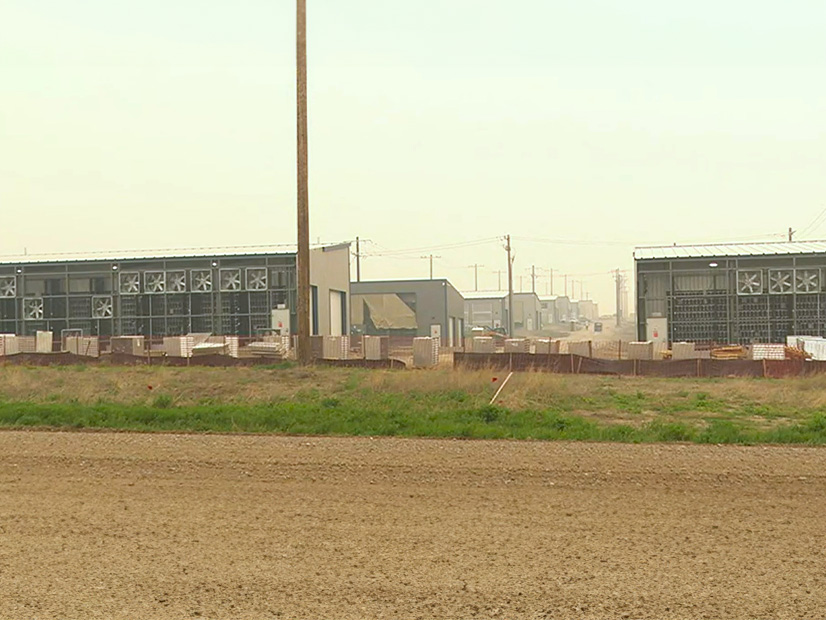SPP, MISO and its Independent Market Monitor are at odds over how congestion should be managed on a market-to-market flowgate taxed by a cryptocurrency mining operation within SPP’s borders.
The three filed comments with FERC this week over whether the 230-kV Charlie Creek-Watford line in North Dakota should remain under M2M coordination, when congestion stemming from the 200-MW Atlas Power Data Center is costing MISO members millions. (See Crypto Load on MISO-SPP M2M Constraint Draws Complaint from Montana-Dakota Utilities.)
Montana-Dakota Utilities filed a complaint on the ongoing controversy in late January, arguing SPP should be found in breach of the grid operators’ joint operating agreement for unjustly taking M2M payments from MISO to manage local congestion. MISO and its IMM agreed the line’s M2M status should be lifted; SPP argued for the status quo (EL 24-61).
SPP contends there is no basis for Montana-Dakota Utilities’ complaint because the more than 3-year-old M2M flowgate is “clearly authorized” by the MISO-SPP joint operating agreement and other arrangements between it and MISO. It said an order for refunds would be illegal in this case, and it asked the commission to deny the complaint.
“Moreover, SPP and MISO are already discussing prospective enhancements to the removal provisions under the JOA’s dispute resolution process. SPP hopes that these discussions will successfully address the future operation of Flowgate 5717, while also avoiding near-term reliability risks and ensuring that similarly situated M2M-coordinated flowgates are treated comparably,” SPP said.
SPP said there’s no need for FERC to initiate hearing and settlement procedures or an alternative dispute resolution and that doing so could be “needlessly disruptive.”
SPP pushed back against Montana-Dakota’s claim that the flowgate is a local constraint, not a regional one. It said the constraint passed multiple eligibility studies before it was designated for M2M coordination.
“To the best of SPP’s knowledge, MISO has never objected to the results of the flowgate studies,” SPP said. The RTO also said it continues to believe M2M coordination on the flowgate is an “effective mechanism to manage congestion.”
SPP also said nothing in MISO and SPP’s agreements prohibits constraints from becoming M2M-coordinated flowgates just because they’re situated in a load pocket.
However, MISO Independent Market Monitor David Patton said the nature of the load addition means Charlie Creek shouldn’t be designated as an M2M flowgate.
Patton said while Charlie Creek technically passed the tests laid out in MISO and SPP’s congestion management process, the flowgate’s congestion now is local and is “not a regional issue that M2M coordination was intended to address.” He added that MISO, SPP and PJM in the past have agreed to remove flowgates from M2M procedures on a case-by-case basis when impacts are found to be local.
“[I]t is understood that this congestion is almost entirely managed by generation inside the [Williston load pocket (WLP)], almost none of which is operated by MISO. Likewise, MISO has no meaningful resources that can be used outside the WLP to provide relief on the Charlie Creek flowgate. These characteristics clearly indicate that the congestion on the Charlie Creek flowgate is local in nature and, as such, was never intended to be the type of flowgate that should be coordinated,” the Monitor argued.
MISO itself said negotiations with SPP over the flowgate effectively are at a stalemate. It said it is seeking immediate removal of Charlie Creek from joint congestion management and for SPP to return all associated M2M payments it made to SPP starting April 1, 2023. MISO said the “only practical result of the M2M coordination on that flowgate is an unjustified financial subsidy to SPP from MISO customers.”
MISO told FERC it objects to “SPP’s improper application of the M2M coordination protocol” on the Charlie Creek line. But it said it remains unable to remove Charlie Creek from M2M coordination, even after engaging in negotiations with SPP pursuant to their formal dispute resolution rules.
The MISO-SPP JOA allows the RTOs to cease M2M congestion management on flowgates when the process isn’t effective at curbing congestion. However, both MISO and SPP must consent to striking the flowgate from congestion coordination before it can be terminated.
MISO said it has repeatedly requested that SPP agree to eliminate the M2M designation on the line, but SPP “steadfastly refused, turning the consent requirement into a veto.”
MISO asked FERC to take swift action to “stop the unjustified flow of M2M payments” and direct it and SPP to draft revisions to their M2M coordination procedures to avoid similar situations in the future. It asked that FERC fast track Montana-Dakota Utilities’ complaint, given that its M2M payments to SPP are likely to rise when lower, summer ratings are applied to the line beginning in April.
MISO said it was well known that the Williston load pocket had longstanding congestion issues and said the recent load addition means its resources can offer near-zero relief.
“When SPP added a significant new load, the Atlas Power Data Center, to the WLP in early 2023, it exacerbated the existing constraints while neither SPP nor MISO have sufficient generation in the area to relieve those constraints. In other words, there is no economic M2M coordination solution that the RTOs may provide through redispatch to alleviate congestion,” MISO explained.
MISO argued that SPP acknowledged the load pocket’s issues in its 2021 Integrated Transmission Planning Report prior to the cryptocurrency mining facility’s operation. In the 2021 report, SPP said “the root of the issues in the [Williston load pocket] is the lack of transmission to accommodate the level of transfers required to serve the forecasted load in the future, contributing to a weak system unable to maintain acceptable voltage levels.”



